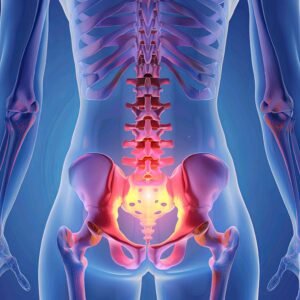Pelvic Floor Health: Why It’s Crucial at Every Stage of Womanhood?
Let’s talk about something that doesn’t get nearly enough attention—pelvic floor health. It might not be the most glamorous topic, but it’s incredibly important for women at every age and stage of life. From teenage years through pregnancy, postpartum, menopause, and beyond, your pelvic floor is quietly working behind the scenes to support some of your body’s most vital functions.
But what exactly is the pelvic floor? Why does it matter so much? And more importantly, what can you do to keep it healthy?
What is the Pelvic Floor?
Think of your pelvic floor as a hammock of muscles that stretch from your pubic bone in the front to your tailbone in the back. This group of muscles supports your bladder, bowel, uterus, and vagina. These muscles play a huge role in your ability to control urination and bowel movements, enjoy sex, and even give birth.
When these muscles are strong and working well, life feels pretty normal. But when they’re weakened or injured, it can lead to all sorts of issues—leakage, pain, and even prolapse (when organs start to slip out of place). And no, these issues are not just a “mom thing” or a problem for “older women.” They can happen to anyone.

Why Does Pelvic Floor Health Matters at Every Age?
You might be surprised to learn how much your age and stage in life affect your pelvic floor. Here’s how pelvic floor health plays a role throughout different phases of womanhood:
Teenage Years: Building the Foundation
You probably didn’t hear your high school health teacher talk about the pelvic floor. But that doesn’t mean it isn’t important during your teenage years. This is a time when your body is developing, and starting good habits now can prevent problems later.
Excessive straining during bowel movements, poor posture, and holding in urine for too long can all take a toll. And let’s not forget about the impact of high-intensity sports. Activities like gymnastics, running, or dance that involve jumping can stress the pelvic floor if you’re not training properly.
Tip: Encourage young women to be body-aware. Regular stretching, strength training, and avoiding constipation are all great early habits.
20s and 30s: Preparing for Pregnancy and Beyond
For many women, the 20s and 30s are prime childbearing years. This is when pelvic floor health becomes even more critical. Pregnancy places a massive load on these muscles. Then comes labor and delivery, which can stretch, strain, or even tear the pelvic floor.
Even if you’re not planning to have kids, your lifestyle choices in these years matter. Hours spent sitting at a desk, poor workout form, or chronic stress (which causes you to clench your pelvic muscles) can start to chip away at pelvic floor strength.
Tip: Consider incorporating pelvic floor exercises, like Kegels, into your routine. But also learn to relax these muscles—over-tightening can be just as problematic.
The Postpartum Period: Healing the Core
After childbirth, your body goes through a significant recovery process. And your pelvic floor is front and center in that healing. Whether you had a vaginal delivery or a C-section, the pelvic region needs TLC. Issues like incontinence, painful sex, and pelvic heaviness are common—and should not be ignored.
What’s frustrating is that many women are told these symptoms are “just part of motherhood.” They’re not. They’re signs that your pelvic floor might need attention.
Tip: Don’t hesitate to see a pelvic floor physical therapist after giving birth. It should be as normal as a postpartum check-up with your OB.
40s and 50s: The Menopausal Shift
Hormonal changes during perimenopause and menopause can impact pelvic floor tissues. Estrogen levels drop, which affects muscle tone, collagen production, and even vaginal moisture. You might notice new symptoms like urgency, leakage, or prolapse.
Even if you’ve never had kids, the aging process can weaken the pelvic floor. And if you’ve had multiple births or past injuries, this is when they can really start to show up.
Tip: Staying active, maintaining a healthy weight, and addressing issues early can make a big difference. There are also pelvic-friendly hormone therapies to explore with your doctor.
60s and Beyond: Aging Gracefully and Comfortably
In the later decades of life, pelvic floor health continues to matter—perhaps even more than before. Falls become a concern, and your core (which includes the pelvic floor) plays a crucial role in balance and stability. Plus, dealing with incontinence or prolapse can seriously impact your quality of life.
The good news? It’s never too late to improve pelvic floor function.
Tip: Low-impact exercises like walking, Pilates, and water aerobics can help keep muscles engaged without overwhelming them.
Signs Your Pelvic Floor Might Be Struggling
So how do you know if your pelvic floor needs help? Here are some common red flags to watch for:
- Leaking urine when you laugh, cough, sneeze, or exercise
- Frequent or sudden urges to urinate
- Constipation or straining during bowel movements
- Pain during sex
- Feeling like something is “falling out” down there
- Lower back or pelvic pain with no clear cause

If any of these sound familiar, it’s worth checking in with a pelvic health specialist. Don’t let embarrassment keep you from getting help—these are medical issues, and they’re more common than you think.
Let’s Bust a Few Pelvic Floor Myths
Pelvic floor health has been wrapped in a lot of myths and misinformation. Let’s clear some things up:
Myth 1: Only moms need to worry about pelvic floor health.
False. You don’t need to have given birth to experience pelvic floor dysfunction.
Myth 2: Kegels are the solution to everything.
Not necessarily. Kegels are helpful, but only when done correctly—and only when strengthening is needed. Some women actually need to focus on relaxation instead.
Myth 3: Leaking a little urine is normal after a certain age.
It’s common, but not normal. And there are ways to treat it.
How to Support Your Pelvic Floor Daily?
Now that you know how important pelvic floor health is, here are some daily habits that can make a big difference:
- Practice good posture – slouching affects how your pelvic organs sit and function.
- Breathe deeply – your diaphragm and pelvic floor work together; deep belly breathing supports both.
- Avoid straining – if you’re constipated, treat it rather than push through it.
- Stay hydrated – water helps keep everything moving smoothly.
- Move your body – regular, gentle exercise keeps pelvic muscles engaged.

If you’re already dealing with symptoms, don’t tough it out. A women’s health physical therapist can design a personalized plan based on whether your muscles are too tight, too weak, or not coordinating properly.
Pelvic Floor Health and Mental Well-Being
Let’s not overlook the emotional side of things. When you’re dealing with chronic discomfort or anxiety about leaking, it can take a toll on your confidence and relationships. Intimacy may become stressful, and physical activities may feel off-limits.
That’s why pelvic floor health isn’t just a “physical” issue—it’s a whole-person issue. Addressing it can bring back freedom, comfort, and even joy in everyday life.
Final Thoughts:
Here’s the bottom line: pelvic floor health is essential, and it deserves our attention. It’s not just a postpartum problem or something you deal with “when you’re older.” It’s a core part of a woman’s well-being, from adolescence through your golden years.
So let’s normalize the conversation. Let’s teach our daughters. Let’s support each other in motherhood. Let’s advocate for better postpartum care. Let’s stop accepting discomfort as “just part of being a woman.”



